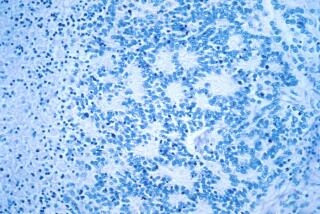New Cancer Fighter Found : But Won’t Be Available Until After More Testing
- Share via
Scientists at the National Cancer Institute have found a way to transform quiescent white blood cells into cancer “killers” that the researchers believe is the first new approach to treatment of the disease in decades.
In a preliminary trial on 25 patients with cancers so advanced that they no longer responded to chemotherapy or radiation, the researchers report that the activated killer cells were able to reduce the size of tumors by more than 50% in 11 of the patients. The regression of the cancer has been complete for 10 months in one patient who had melanoma, a serious form of skin cancer, that had formed numerous individual tumor modules.
Because the shrinking of tumor size occurred in four different types of cancer--melanoma, colorectal, kidney and lung--the scientists said the treatment appears to have potential for broad application. However, they caution that their study leaves unanswered many important questions, such as the safety of using the technique on large numbers of patients and the duration of the benefits. The treatment also caused serious side effects in some patients.
Even if continued small-scale trials are successful, it is likely to take years before it is widely available. In the future, the scientists said, they plan to try to improve the therapy by combining it with chemotherapy or radiation or by injecting the activated cells directly into the tumor instead of the bloodstream.
Researchers report in the Dec. 5 issue of the New England Journal of Medicine that the initial results have encouraged them to believe that the method “represents a possible new approach to the treatment of cancer, with potential applicability to a wide variety of tumors.”
The treatment consists of using specialized machines to remove a particular kind of white blood cells--called lymphocytes--from the patient’s bloodstream, according to Dr. Steven A. Rosenberg, chief of the surgery branch in the institute’s division of cancer treatment in Bethesda, Md., and principal investigator in the study.
The lymphocytes are incubated in a laboratory dish with a large amount of a interleukin-2, a protein produced by the body in minute quantities. Interleukin-2, the scientist said, transforms the lymphocytes into killer cells capable of destroying cancer cells but not normal ones.
The activated cells are then injected into the patient, followed by additional doses of interleukin-2 at various intervals afterward. Unlike other so-called killer cells that are formed naturally in the body, the lymphocytes used in the new therapy are apparently quiescent until they become activated in the laboratory by interleukin-2.
Tiny Amounts
Although interleukin-2 is manufactured naturally by the body, it is present only in tiny amounts, according to Rosenberg, and does not result in the lymphocyte alteration that occurs when the amount of interleukin-2 is artificially increased.
“What we are doing outside the body does not occur naturally inside the body, as far as we now know,” Rosenberg said in a telephone interview.
He said he believes the reason the lymphocyte transformation does not occur in the body is because it requires millions of times more interleukin-2 than is present naturally.
However, giving the patients large amounts of the protein resulted in toxic effects that included severe respiratory distress, rash, fever and chills.
Artificially manufacturing large quantities of the protein was not possible until the recent development of recombinant DNA technology, which enables scientists to use bacteria--in which the human gene for interleukin-2 has been implanted--to make almost unlimited amounts. A California company, the Cetus Corp. of Emeryville, supplied the interleukin-2.
No Regression
The National Cancer Institute scientists said they previously had treated 26 cancer patients with the activated killer cells alone and another 39 with interleukin-2 alone but saw no regression of the cancers in any of them. The benefits, they said, occurred only when the activated cells and the protein were used together.
“For the first time,” Rosenberg said, “we can take the immune system of a patient, alter it, and use it to cause regression of a tumor. This represents the first step in the development of a whole new treatment of cancer. Not since the development of chemotherapy 30 years ago has there been a completely new treatment for cancer.”
Previously cancer treatment has been limited to surgery, radiation and chemotherapy.
On Wednesday, a foundation established by Dr. Armand Hammer, head of Occidental Petroleum Corp., announced that Rosenberg and Dr. Tadatsugu Taniguchi of Osaka University, Japan, have been awarded a $100,000 prize for their contributions to the experimental therapy using interleukin-2.






